The Intel Core i9-12900KS Review: The Best of Intel's Alder Lake, and the Hottest
by Gavin Bonshor on July 29, 2022 8:00 AM ESTCPU Benchmark Performance: Power, Office, and Science
Our previous set of ‘office’ benchmarks have often been a mix of science and synthetics, so this time we wanted to keep our office section purely on real-world performance.
For the remainder of the testing in this review of the Core i7-12700K and i5-12600K, we are using DDR5 memory at the following settings:
- DDR5-4800(B) CL40
Power

Compared directly to the Core i9-12900K, the Core i9-12900KS does draw more power in our Peak Power test, albeit not immensely more. Because Intel has assigned the chip the same 241W PL1 limit as the original 12900K, in TDP-constrained scenarios both chips are held to a similar limit. Still, with a figure of 276.44 W, this is considerably more than other processors including all of AMD's premium 5000-series offerings, and Intel's 12th Gen Core i5 and i7 processors.
Office
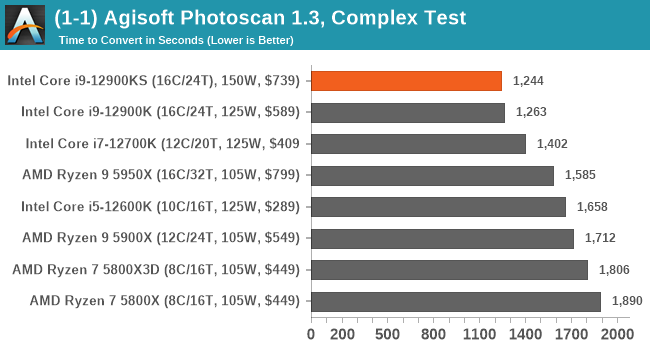
In our Agisoft Photoscan 1.3 benchmark, the Core i9-12900KS is around 1.5% better than the regular i9-12900K, and considerably quicker than the rest on test.
Science
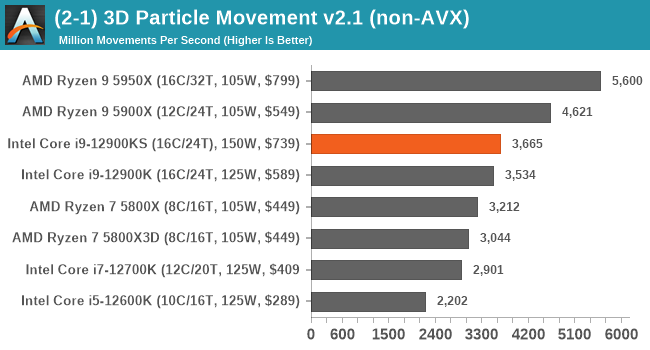
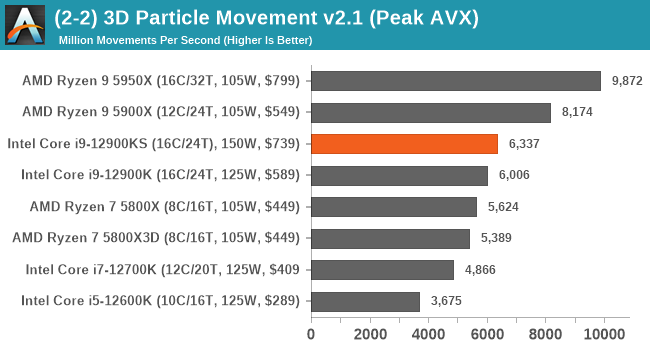
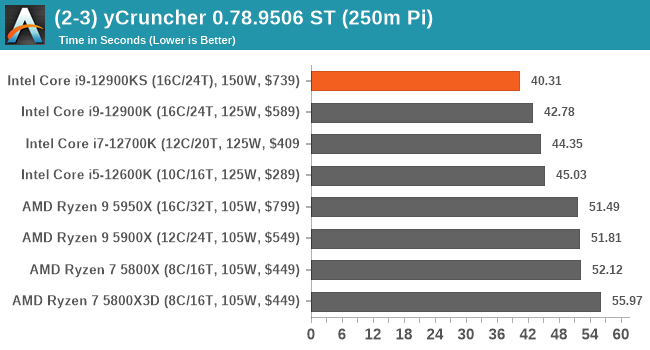
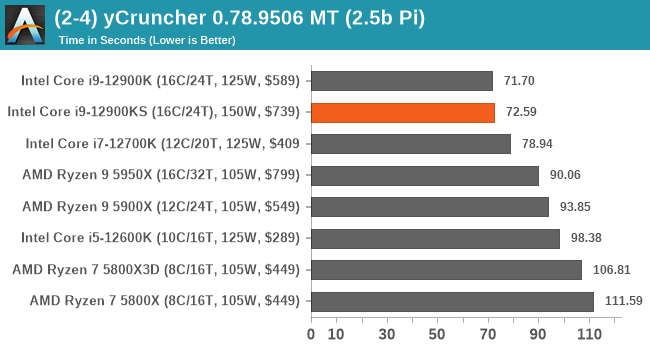
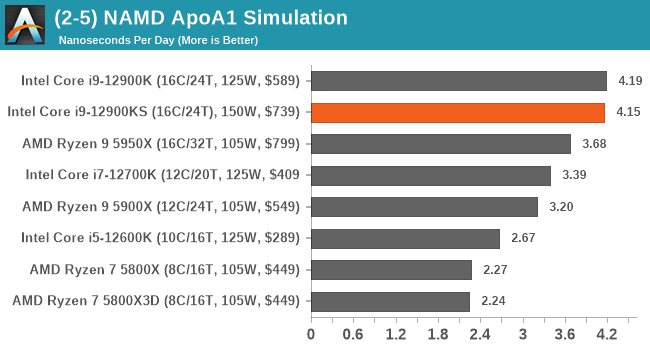
In our science-based benchmarks, the Core i9-12900KS and the Core i9-12900K trade blows which is to be expected with two similar processors, albeit the extra core clock speeds on the i9-12900KS do not show as much benefit as the price difference would suggest.










56 Comments
View All Comments
fazalmajid - Friday, July 29, 2022 - link
Meh. What I want is a HEDT CPU with only P-cores, and AVX-512 re-enabled as a result. Perhaps Sapphire Rapids will deliver that.nandnandnand - Friday, July 29, 2022 - link
Fishhawk Falls, Q4 launch maybe.https://www.notebookcheck.net/16-cores-32-threads-...
https://wccftech.com/intel-hedt-sapphire-rapids-w7...
Silver5urfer - Friday, July 29, 2022 - link
HEDT is dead.Intel won't release an X299 successor. Their new Sapphire Rapids based HEDT is W, Workstation class. Meaning Prosumer just like Threadripper Pro. So expect a super high premium asking price.
Gaming and Mobile industry killed HEDT. Nowadays most of them spend more time on their junk Smartphone consuming all the stupid Social media drama and etc. So PC users are only relegated to those so called "Gaming" which is mostly - Fortnite, Pubg, COD Warzone, Apex Legends. All this garbage. Not SP games. And Windows 11 direction is also more geared towards mobile UI.
All in all HEDT is essentially gone.
brucethemoose - Friday, July 29, 2022 - link
I disagree, as I think the core count wars killed HEDT.No game I know of (other than one beta MMO) can fully saturate a top end consumer CPU these days. And most workloads will get done *reasonably* quickly on a 12900KS or 5950X.
You need more? Well thats what the P/W series is for. There's a lot of fixed-cost overhead designing something like X299 or TR4, and I don't think the volume justifies it over just making some workstationy motherboards/CPUs on a heavily amortized server socket.
StevoLincolnite - Friday, July 29, 2022 - link
My old 3930K from over 10 years ago is still playing the latest and greatest games just fine. Overclocks like a champ too.Running Ryzen 9 at the moment with 64GB of Ram.
But Quad Channel+6 Core/12 threads is what gave it that longevity because it's a HEDT platform.
Fast forward to today... They essentially just moved HEDT chips onto consumer platforms and dialed up the core counts... Which is why the price points of high-end Ryzen 9 can align itself to older HEDT chip price brackets of old.
There just isn't a dedicated socket for it anymore... Or Quad channel memory.
michael2k - Saturday, July 30, 2022 - link
I don’t think it’s possible to make a CPU faster anymore until Intel gets to 4nm; it just takes too much power.So their only choice is wider and more cores. Apple is a node ahead and will probably hit 3nm next year when Intel hits 4nm.
StevoLincolnite - Sunday, July 31, 2022 - link
Keep in mind that nodes are not directly comparable based upon pure marketing nomenclature.Intel 7nm for example is absolutely superior to TSMC or Samsung 7nm in actual feature sizes.
michael2k - Sunday, July 31, 2022 - link
Yes you are correct but also irrelevant. Intel 7 may be superior to TSMC 7 but inferior to TSMC 5 or TSMC 5PZoolook - Monday, August 1, 2022 - link
I guess you mean Intel 7, which is their renamed 10nm, and it's debatable, Intel 7 never reached their initial proposed logical density and in comparisons of chips they seem to have less than 10% lead in density and their volume production launched years after TSMC and it's clearly worse in power efficiency.TSMC is gearing up volume production on N3 which is a year ahead of Intels comparable (projected density) Intel 4 process.
michael2k - Saturday, July 30, 2022 - link
It’s funny how Apple still has a ‘jest’ CPU; 16 pcores and 4 ecores in the M1 Ultra.But AMD still sells a 16 core part too:
https://nanoreview.net/en/cpu-compare/apple-m1-ult...
https://www.amd.com/en/products/cpu/amd-ryzen-9-59...
The real question is if core counts will go up with the M2 Ultra; adding 2 p cores to the M2 Max (10/2) would give the M2 Ultra 20/4
The problem Intel and AMD have is that their power draw is so high it gets hard to add more cores and still cool the part.